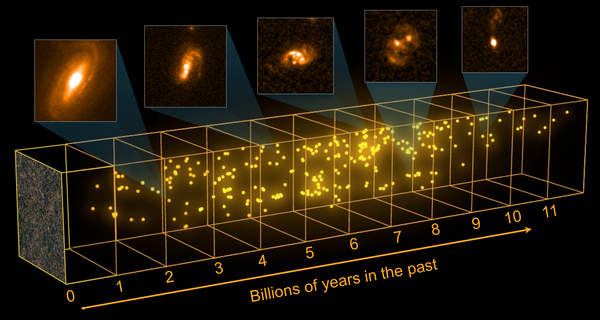Herschel's chronicles of galaxy evolution
20 September 2017
Delving deep into the history of our cosmos, the Herschel Space Observatory scrutinised hundreds of thousands of star-forming galaxies, peering back in time to when the Universe was less than one billion years old. These observations probed the peak epoch of stellar production, about ten billion years ago, when galaxies were forming stars roughly ten times faster than their present counterparts.| Herschel: galaxy evolution. Click here for details and large versions of the video. Credit: ESA/Herschel/NASA/JPL-Caltech; acknowledgement: T. Pyle & R. Hurt (JPL-Caltech); Galaxy formation simulation courtesy of Illustris Collaboration; Big Bang Timeline art courtesy of Rhys Taylor/rhysy.net |
Looking at the starry spectacle of the night sky, we might be tricked by its seemingly timeless beauty to think that the multitude of distant suns have been there since the beginning of time. But, if our eyes could peer back into cosmic history up to the first few seconds of our Universe, almost 14 billion years ago, they would be treated to a very different view.
Shortly after the Big Bang – the hot and dense phase that sets our cosmic tale into motion – the Universe was very different from what we can observe nowadays, and it took a few hundred million years for stars and galaxies to start to emerge from the primordial 'soup' that filled the early cosmos.
Piecing together how galaxies formed and evolved, giving birth to stars at different paces throughout the history of the Universe, is one of the most intriguing and challenging topics in present day astrophysics and cosmology research.
Infrared is the key
In their quest to investigate how galaxies differ at various cosmic epochs, astronomers have been collecting increasingly larger samples, searching for the light that was emitted by galaxies many billions of years ago and that has been travelling across the Universe ever since. These studies greatly benefit from combining observations at different wavelengths of light, with the infrared band being crucial to pinpoint galaxies that are fiercely forming stars.
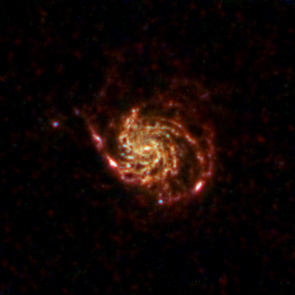 |
| Herschel's view of the Pinwheel Galaxy. Credit: ESA/Herschel/NASA/JPL-Caltech, CC BY-SA 3.0 IGO; Acknowledgement: R. Hurt (JPL-Caltech) |
Star formation in galaxies takes place within dense clouds of gas that, for most of cosmic history, also contain small amounts of dust. Newborn stars shine brightly in ultraviolet and visible wavelengths, but only about half of this starlight, on average, leaves a galaxy unhindered; neighbouring dust grains absorb the other half, radiating it again but, this time, at longer wavelengths.
As a result of the dust interspersed in the interstellar material, galaxies emit roughly 50 per cent of their total light at mid-infrared, far-infrared, and sub-millimetre wavelengths – between 8 micron and 1 mm – with a peak in the far-infrared, around 50-200 microns. For this reason, observations in this spectral range are fundamental for quantifying a galaxy's star formation activity.
In addition, the expansion of the Universe stretches the wavelengths of light emitted by distant objects. This effect, known as redshift, becomes increasingly more significant the farther a galaxy is from us.
This causes the peak of dust emission to move from the far-infrared to sub-millimetre wavelengths. Therefore observations that cover these two portions of the electromagnetic spectrum complement each other, capturing dusty emission from star formation in both nearby and distant galaxies.
Performing observations at infrared wavelengths with telescopes on the ground, however, is generally difficult – if not impossible – because of the presence of Earth's atmosphere, so astronomers turned to space.
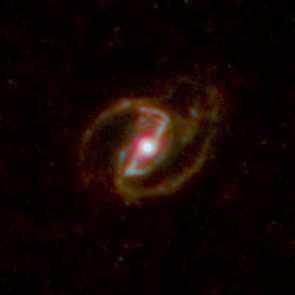 |
| Herschel's view of NGC 1097. Credit: ESA/Herschel/NASA/JPL-Caltech, CC BY-SA 3.0 IGO; Acknowledgement: R. Hurt (JPL-Caltech) |
In the early 1980s, the US-Dutch-British Infrared Astronomical Satellite (IRAS) was the first space mission to map the sky in the far-infrared, followed by ESA's Infrared Space Observatory (ISO) in the late 1990s, NASA's Spitzer Space Telescope, launched in 2003, and JAXA's Akari, which operated between 2006 and 2011.
With mid-infrared observations from ISO and Spitzer, astronomers started to perceive the glow of warm dust from individual star-forming galaxies sprinkled across the Universe's history. But it was only with ESA's Herschel Space Observatory, launched in 2009 and operational until 2013, that these investigations unleashed their full potential.
The observatory's broad spectral coverage, including the far-infrared and sub-millimetre range, extended to longer wavelengths than those probed by Spitzer, ISO, and Akari. As a result, astronomers could sense cooler dust than that which had been detected by its predecessors.
With its unprecedented angular resolution, Herschel could also spot galaxies that had been missed by these earlier observatories at the wavelengths they had in common.
In addition, and perhaps most importantly, its particular spectral range made it possible to catch galaxies whose light had been redshifted to longer wavelengths than those probed by its predecessors, tracing out star formation to greater distances and thus earlier times in cosmic history.
With a 3.5-metre primary mirror, Herschel sported the largest infrared telescope flown to date, granting astronomers unprecedented sensitivity that was crucial to observe star-forming galaxies across the Universe.
Scrutinising the evolution of galaxies was the focus of various Key Programmes that dedicated over 2000 hours to these observations – among them, the Herschel Multi-tiered Extragalactic Survey (HerMES), the PACS Evolutionary Probe (PEP), and the Herschel Astrophysical Terahertz Large Area Survey (H-ATLAS).
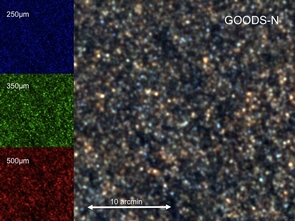 |
| The GOODS-North field as viewed by the SPIRE instrument on Herschel. Credit: ESA/SPIRE Consortium/HerMES Key Programme Consortium |
Following in the footsteps of previous studies based on Spitzer data, Herschel allowed astronomers to resolve the diffuse 'fog' known as the cosmic infrared background radiation into hundreds of thousands of individual, actively star-forming galaxies, seen as they were at a variety of past epochs. Herschel's contribution was crucial to push the observations up to the time when the Universe was less than one billion years old, probing the full period when star formation peaked and even beyond.
This result, which has opened new avenues to study the evolution of galaxies, is somewhat suggestive of the revolutionary observations by Galileo who, just over four centuries before, had pointed the newly invented telescope at the diffuse white glow of the Milky Way, breaking it down into a myriad of individual stars.
The heyday of star formation
With its deep surveys of several regions of the sky, Herschel revealed a Universe teeming with star-forming galaxies, their presence uncovered by the glow of dust heated by the stars in the making.
Measuring how bright a galaxy shines in the far-infrared can inform astronomers about how much dust is there and how cool it is, which can be used, in turn, to determine the pace of the galaxy's star formation activity.
In the present Universe, galaxies produce stars at a rather leisurely pace, with our Milky Way giving birth to only a few Sun-like stars every year. However, galaxies have been far more prolific in the past, and Herschel has been instrumental in estimating just how much so.
Stars and galaxies have been bursting into life since the Universe was about half a billion years old, and astronomers now agree that this activity peaked a few billion years later. At that glorious epoch, Herschel confirmed that galaxies were forming stars roughly ten times faster, on average, than they are nowadays.
Shortly after, the average rate of star formation in galaxies began to decline, and it has been consistently doing so over the past ten billion years of cosmic history.
With such a marked difference in the star-forming activity of present and past galaxies, it is legitimate to wonder whether the physical processes that regulate the stellar production also underwent any substantial change over the eons.
Most galaxies in today's Universe are making stars in a steady, gentle fashion, and only rarely do dynamical interactions of galaxies, or mergers, trigger the occasional, intense burst of stellar birth.
Astronomers suspected that galactic mergers might have been responsible for the higher pace of star formation at its peak, ten billion years ago, but hints from Spitzer and, later, more robust evidence from Herschel surprisingly revealed that this was not the case.
In spite of their higher production rates, most galaxies at earlier cosmic epochs seem to be quite 'ordinary': their greater productivity is likely an effect of cold gas – the raw material to make stars – being more plentiful at those times.
Within this scenario, earlier galaxies are not concealing any mysterious mechanism that boosts their star-making efficiency, but are most likely just scaled-up versions of the galaxies we observe at the present time.
This result relegates merger-triggered starbursts to a minor role in the total history of star formation; the decisive ingredient seems to be a steady supply of cold gas, which could well be provided by intergalactic streams – as suggested by numerical simulation of cosmic structure formation.
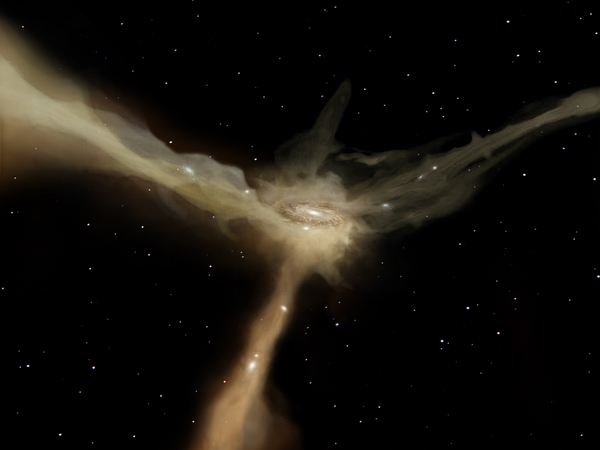 |
| Artist's impression of a galaxy forming stars in a gentle and steady fashion. Credit: ESA/AOES Medialab |
In addition, Herschel demonstrated that, at any given time in the Universe, the vast majority of star-forming galaxies seem to obey a very simple rule: the more massive a galaxy, the faster it is forming new stars. This relation, called the Galaxy Main Sequence, had already been identified using Spitzer observations of galaxies in more recent epochs, but Herschel confirmed that it applies also to earlier times.
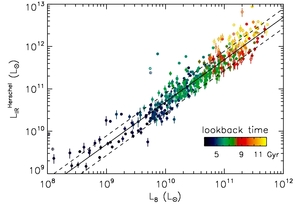 |
| The 'infrared main sequence' for star-forming galaxies. Image courtesy of David Elbaz. |
That such a relation seems to be true across most of cosmic history is remarkable, suggesting that relatively simple mechanisms must be regulating the complex process of a galaxy turning its interstellar material into stars.
Only a small fraction of extremely prolific starburst galaxies appear to break this rule, in the earlier and later Universe alike. Herschel did find that such behemoths were slightly more abundant at earlier times, but demonstrated that they were never the primary channel of star formation at any epoch. Indeed, the fierce activity of stellar production observed in starburst galaxies seems not to be sustainable over long periods of time, causing them to rapidly quench their star formation.
More recently, new analyses of Herschel observations have shown that the situation may not be so clear-cut after all. These studies indicate that the Galaxy Main Sequence might break down also in the case of very massive galaxies, suggesting that, as galaxies grow more massive by accreting cold gas, they could reach a point where they stop forming stars very efficiently. The reasons for this change in behaviour are still being investigated.
The role of feedback
What caused the drop in star formation rate, ten billion years ago, and its overall declining trend ever since?
While it is evident that, in the past, galaxies had at their disposal a much larger supply of raw material from which to form stars than they do at present, the physical processes that drained them of their reservoirs of interstellar gas (and dust) are still not fully understood. Similarly, astronomers are still probing the possible mechanisms underlying the Galaxy Main Sequence.
Another open issue concerns a striking similarity observed between the long-term history of two apparently disparate processes that take place in galaxies: the formation of stars and the accretion of matter onto the supermassive black holes that are lurking at their cores: both processes appear to peak around ten billion years ago. How can the evolution of black holes, which are relatively small-sized and confined at the centre of their host galaxies, be linked to the star-forming activity that takes place on much larger scales?
The answer to some – or perhaps all – of these questions might lie in the 'feedback' effects exerted on the interstellar material that pervades a galaxy by stellar radiation and winds, supernova explosions, and outflows possibly triggered by the activity of its central black hole.
Astronomers have long been studying the role of feedback on galaxy evolution using a variety of observations across the spectrum. Looking at nearby galaxies that are forming stars more briskly than most of their neighbours, Herschel brought important input to this quest.
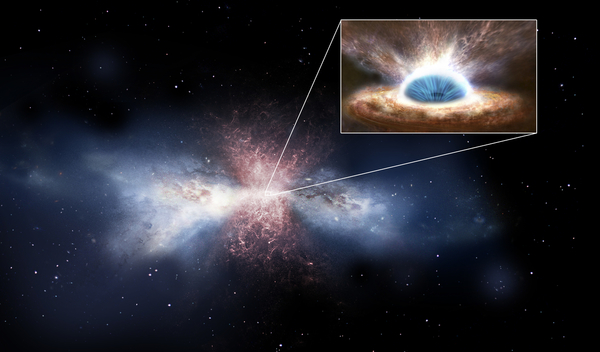 |
| Black-hole winds sweep away the gas in galaxies - Artist's impression. Credit: ESA/ATG medialab |
Using Herschel data, astronomers discovered massive outflows of molecular gas streaming away from the cores of several star-forming galaxies in the local Universe. While outflowing gas in neutral and ionised form had been observed in earlier studies, this was the first detection of massive outflows of molecular gas – crucial in the making of stars – being pushed away from a galaxy. The strongest outflows were seen in galaxies that host actively accreting supermassive black holes at their centre, hinting at a role for black-hole feedback in draining a galaxy's reservoir of star-forming material.
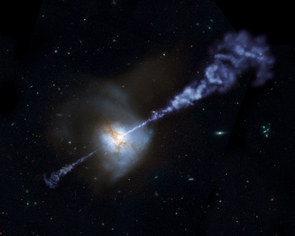 |
| Artist's impression of galactic outflows. Credit: NASA/JPL-Caltech/R. Hurt |
Further clues were found in nearby radio galaxies, which exhibit symmetric jets of plasma flying out, at the speed of light, from the central black hole. These jets definitely have the power to affect the gas on much larger scales and perhaps even to impede the host galaxy's star formation.
Herschel observations were also key to proving a crucial aspect in these feedback matters, uncovering for the first time the causal link between the black hole activity at the centre of a galaxy and the gas outflows seen on much larger scales. This was made possible by comparing a galactic-wide outflow of molecular gas, detected by Herschel, with X-ray data probing a powerful wind of ionised gas driven by the black hole at the core of the galaxy. Observing these two phenomena in the same galaxy for the first time, astronomers further demonstrated the role played by black holes in regulating the formation of stars in their host galaxies.
Making sense of it all
To get to the bottom of how differently galaxies evolved across the history of the Universe, observations are compared with the predictions from computer simulations, which attempt to reproduce the build-up of cosmic structures on very large scales. Many new simulations have also embraced the very challenging task of including a number of small-scale processes to account for the feedback effects caused by star formation or the activity of supermassive black holes.
As for Herschel's survey of over 12 billion years of star formation, a comparison with the simulated cosmos showed that some processes underlying galaxy evolution seem to be well understood, but many details remain unclear. Simulations are still far from reproducing the complex and diverse properties recorded by surveys of galaxies, especially concerning the link between feedback and star formation, and there is still much work to do before all pieces of this cosmic puzzle fall into place.
Nevertheless, Herschel's unprecedented observations are greatly helping astronomers in their ambitious endeavour of assembling the complex history of how stars and galaxies formed and evolved in the cosmos. Pushing the experimental boundaries farther than any of its predecessors, the mission has revealed a number of previously hidden gems, near and far, that have been crucial to piecing together this intriguing tale, while at the same time it also uncovered new mysteries that will keep astronomers busy for the foreseeable future.
More information
Herschel is an ESA space observatory with science instruments provided by European-led Principal Investigator consortia and with important participation from NASA.
Herschel was launched on 14 May 2009 and completed science observations on 29 April 2013.
All Herschel data can be accessed from the Herschel Science Archive at http://archives.esac.esa.int/hsa/whsa/
For further information please contact:
Göran Pilbratt
Herschel Project Scientist
Directorate of Science
European Space Agency
Email: gpilbratt![]() cosmos.esa.int
cosmos.esa.int
Phone: +31-71-565-3621
Philip Appleton
Herschel Project Scientist and Task Lead at Caltech/IPAC-Herschel
NASA Herschel Science Center
Email: apple![]() ipac.caltech.edu
ipac.caltech.edu
Phone: +1-626-395-3119

